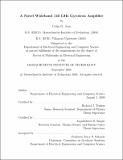A novel wideband 140 GHz gyrotron amplifier
Author(s)
Joye, Colin D., 1980-
DownloadFull printable version (2.507Mb)
Other Contributors
Massachusetts Institute of Technology. Dept. of Electrical Engineering and Computer Science.
Advisor
Richard J. Temkin and Jagadishwar R. Sirigiri.
Terms of use
Metadata
Show full item recordAbstract
The theory, design and experimental results of a wideband 140 GHz, 1 kW pulsed gyro-traveling wave amplifier are presented. The gyro- TWA operates in the HE(0,6) mode of a novel cylindrical confocal waveguide using a gyrating electron beam. The electromagnetic theory, interaction theory, design processes and experimental procedures have been described in detail. The experiment has produced over 820 W peak power, 34 dB linear gain, and a -3 dB bandwidth of over 1.5 GHz (1.1%) from a 37 kV, 2.7 A electron beam having a beam pitch factor of 0.6, radius of 1.9 mm and calculated perpendicular momentum spread of approximately 9%. The gyro-amplifier was nominally operated at a pulse length of 2 microseconds, but was tested to amplify pulses as short as 4 nanoseconds with no noticeable pulse broadening. Internal reflections in the amplifier were identified using these short pulses by time-domain reflectometry. A novel internal mode converter was designed for this device that transforms the confocal HE(0,6) fields into a fundamental Gaussian beam for ultra-low loss transmission of the millimeter wave output power through a corrugated transmission line. The demonstrated performance of this amplifier shows that it can be applied to Dynamic Nuclear Polarization (DNP) and Electron Paramagnetic Resonance (EPR) spectroscopy.
Description
Thesis (Ph. D.)--Massachusetts Institute of Technology, Dept. of Electrical Engineering and Computer Science, 2008. This electronic version was submitted by the student author. The certified thesis is available in the Institute Archives and Special Collections. Includes bibliographical references (p. 143-156).
Date issued
2008Department
Massachusetts Institute of Technology. Department of Electrical Engineering and Computer SciencePublisher
Massachusetts Institute of Technology
Keywords
Electrical Engineering and Computer Science.